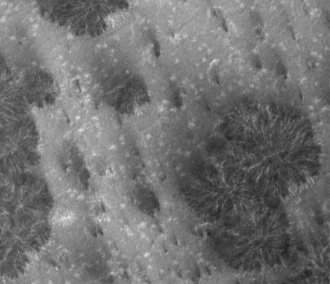Vegetation on Mars June 2, 2010
Author: Beach Combing | in : Modern , trackback
Mars has a long history of befuddling human minds. Think of Giovanni Schiaparelli mapping out the ‘canals’ of that planet. Poor Perceval Lowell wrecking his scientific reputation with such publications as Mars as the Abode of Life. Nevermind all those hopped up Americans taking to the streets after the radio broadcast of War of the Worlds in 1938…
Beachcombing is particularly attracted to the manias of the little man and came across a lovely example the other day in Science Gossip 29 (1893). Clearly a great deal of meticulous work at the telescope went into J. R. Holt’s essay ‘Martian Vegetation’ (p. 155).
‘My preconceived ideas with regard to the Martian vegetation, were, that it was probably reddish or fuscous in colour, and that the laws of its seasonal variation were probably very different from those of our own. The results which I arrived at [through nightly observation] were just the contrary; that the colour was some dark tint, appearing dark green; and that it resembled our own very closely in the way it varied with the seasons. It has been held that the Martian continents owe their reddish colour to some kind of vegetation, and therefore that the Martian vegetation is probably reddish. I do not assert that the Martian continents are not covered with a reddish vegetation; I only say (1) I can find no proof that it is so; (2) this red vegetation appears constant and does not change with the seasons; (3) it shows no tendency to prefer sites near water.
The dark-coloured vegetation is not dispersed over the entire land area; it is confined to places all presumably near water; these are, (1) the canals which appear to be ravines with probably a river at the bottom, but certainly not all water, except in a few cases; and (2) the banks of certain inland lakes, especially Lake Niiacus, Lake Tithonius, and Terby Sea. The way in which it varies with the seasons is different in different latitudes, like our own. Thus take the northern temperate, say N. lat. 45°. The course of variation is as follows. During the winter no trace of vegetation is perceptible. At a Martian date corresponding to the 12-15th March the first signs appear. These early traces are of a reddish or yellowish brown. (Our own woods often assume a reddish-brown colour in early spring, when seen from a distance.) This colour persists through the early part of April, but by the end of May, the dark green or grey coloration has been assumed, and it remains till the end of May, the dark green or grey has been assumed, and it remains till the end of July. Early in August the red colour again appears, and soon after all signs disappear. This apparently corresponds to our ‘fall of the leaf’ but takes place at a comparatively earlier date, corresponding to about 12-27th August. So we see that the general course of vegetation resembles what takes place here, but is about a month earlier.’
J.R.Holt was not first in his claims for Martian vegetation. To the best of our knowledge that was a certain Johann Lambert in the mid eighteenth century: though if readers come across any other eighteenth or nineteenth century references we would be particularly grateful for them. But Holt put forward his thesis with unusual relish. We ask ourselves whether there is anything else he wrote out there in the nineteenth-century science journals: Neanderthal cities in the Himalayas, sea serpents at Brighton? Fingers crossed. drbeachcombing[AT]yahoo[DOT]com
We also note with great pleasure a couple of links to modern searchers after vegetation on Mars: though what are the chances that the links will be dead by the time you get here?
http://www.daviddarling.info/encyclopedia/M/Marsveg.html
http://www.xtl-ak.com/marstrees.html
We include an image from the second at the head of this article.



